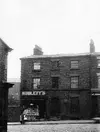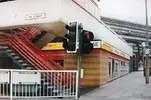Install the app
How to install the app on iOS
Follow along with the video below to see how to install our site as a web app on your home screen.
Note: This feature may not be available in some browsers.
You are using an out of date browser. It may not display this or other websites correctly.
You should upgrade or use an alternative browser.
You should upgrade or use an alternative browser.
Old Photos Of Where You Live
- Thread starter Eggs
- Start date
More options
Who Replied?Merseyside is famous for its football history, but this is where it all began on what is now the spectacular modern Everton Park. When I saw this Village Street image, reproduced on the excellent Netherfield Road & District Faceboook platform, it demanded I offer some more details. The same picture, in a smaller format, appears further down this picture reel along with an artist's impression of the site from the late 1800s when it played a remarkable part in the birth of big time football on Merseyside, The fact that this is heartland Everton will give you a clue. So let's start with this image of Everton Labour Club with electioneering posters up for local Labour candidate of the day Syd Jacob. Many people will remember the building which was finally demolished in the 1960s. However, it belies the real significance of the property which had previously been a well known local dairy that had emerged from a cow keeper's house, supplying fresh milk to the Everton locals for many decades. Before that, this was the Queen's Head pub where the committee of the fledgling St Domingo's Methodist chapel football team, playing at that time in the fairly new Stanley Park, had begun to hold their meetings. At one such gathering, in November 1879, their main agenda item was a potential new name with the team now attracting significant interest in the new game of Association football. After a few hours (and almost certainly a few pints) that night they emerged to proudly declare that St Domingo's would now play under the wider district name of Everton FC. The rest, as they say, is football history. Not only was the Queens Head EFCs first headquarters, it provided the club's first secretary in the shape of John W. Clarke,son of Queens Head landlord John Clarke. On July 18, 2015, I arranged for an archaeological dig to take place at this site to unearth the foundations of the Queens Head Hotel. I got the support of Dr Mark Adams, lead archaeologist from the Museum of Liverpool, along with his colleague Dr Liz Stewart, In the presence of the Everton FC Heritage Society and members of the Friends of Everton Park, this successful dig was a complete success. Victorian bricks and distinctive pub wall tiles began to emerge as did many oyster shells, oysters being a cheap and very popular local pub delicacy in those days. Most significantly, we discovered a Victorian stoneware inkwell. I mused with Dr Adams if this might have been used to sign off the name change from St Domingo's to Everton FC. We could never prove it, of course, but it demonstrated that even archaeologists who deal only in facts can sometimes share a romantic vision. This was all part a research project I undertook for my 2016 book 'Born Not Manufactured'. Along with thousands of other kids, I played my own early football on the steep streets of Everton. I would later progress to become the Liverpool Echo's Everton & Liverpool football correspondent and later sports editor, covering local and national football events, but nothing would give me as much pride and pleasure as discovering where it all began for our massive football city, the site of the Queens Head Hotel . . . Yes, the birthplace of big time football on Merseyside within 30 yards of the tower on Everton FC's badge - Ken Rogers


Here is the old weighing machine that was on the corner of Everton Road and Village Street, pictured in 1904. Lorries would drive on to check their loads. This image gives a tantalising view of the top south side of Village Street with its large properties. A few doors down Village Street was the Queen’s Head Hotel where, in 1879, St Domingo church football team took a momentous decision to change its playing name to Everton FC, the start of big time football on Merseyside. I love the adverts on the wall, specifically one for Hartley’s marmalade, which is particularly relevant. William Hartley, the man who founded the Hartley’s Jam empire with a major factory in Long Lane, Aintree, was one of the individuals who willingly put up a significant part of the money that, in 1892, enabled Everton FC to build its new Goodison Park stadium. Perfectly fitting to have a Hartley's advert on a gable end wall around the corner from a major EFC historic site -


Denis Hargreaves of the Netherfield Road & Surrounding Area Facebook platform uploaded this fascinating 1890s picture of the Noblett's Everton Toffee Shop on Village Street, close to the site of the original cottage from where a young Molly Bushell started making her toffee in the mid 1700s. Molly would never grasp the ultimate football link. She died in 1818, 61 years before the fledgling St Domingo's football team met at the Queens Head Hotel on Village Street (1879) and decided to change their name to Everton FC. The rest, of course, is football history. By then Everton Toffee had earned national renown, leading to the Blues being dubbed the Toffees. The advert below shows how quickly it gained royal patronage -


The cottages and properties that made it such an historical place for hundreds of years have all gone, Everton's famous Village Street being something of a green oasis these days. Established trees are the new residents on the southern boundary of the modern Everton Park, this image looking down towards Brow side and Netherfield Road South. On the left once stood the famous Queen's Head pub where, in 1879, St Domingo's fledgling football team had a meeting and decided to change their name to Everton FC. This rather desolate looking spot was therefore the birthplace of big time football on Merseyside and the rest, as they say, is history. It is marked only by a heritage board installed by the Friends of Everton Park, although a successful archaeological dig took place on the site in 2015 -


Here is the old weighing machine that was on the corner of Everton Road and Village Street, pictured in 1904. Lorries would drive on to check their loads. This image gives a tantalising view of the top south side of Village Street with its large properties. A few doors down Village Street was the Queen’s Head Hotel where, in 1879, St Domingo church football team took a momentous decision to change its playing name to Everton FC, the start of big time football on Merseyside. I love the adverts on the wall, specifically one for Hartley’s marmalade, which is particularly relevant. William Hartley, the man who founded the Hartley’s Jam empire with a major factory in Long Lane, Aintree, was one of the individuals who willingly put up a significant part of the money that, in 1892, enabled Everton FC to build its new Goodison Park stadium. Perfectly fitting to have a Hartley's advert on a gable end wall around the corner from a major EFC historic site -
View attachment 266273
…..around the corner from me when growing up.
St Ruperts tower -
Prince Rupert surely? or have I got it wrong?……fine pic, i remember Ann Fowlers, close to St Rupert’s Tower.

Prince Rupert surely? or have I got it wrong?
….of course you’re right, Kev









